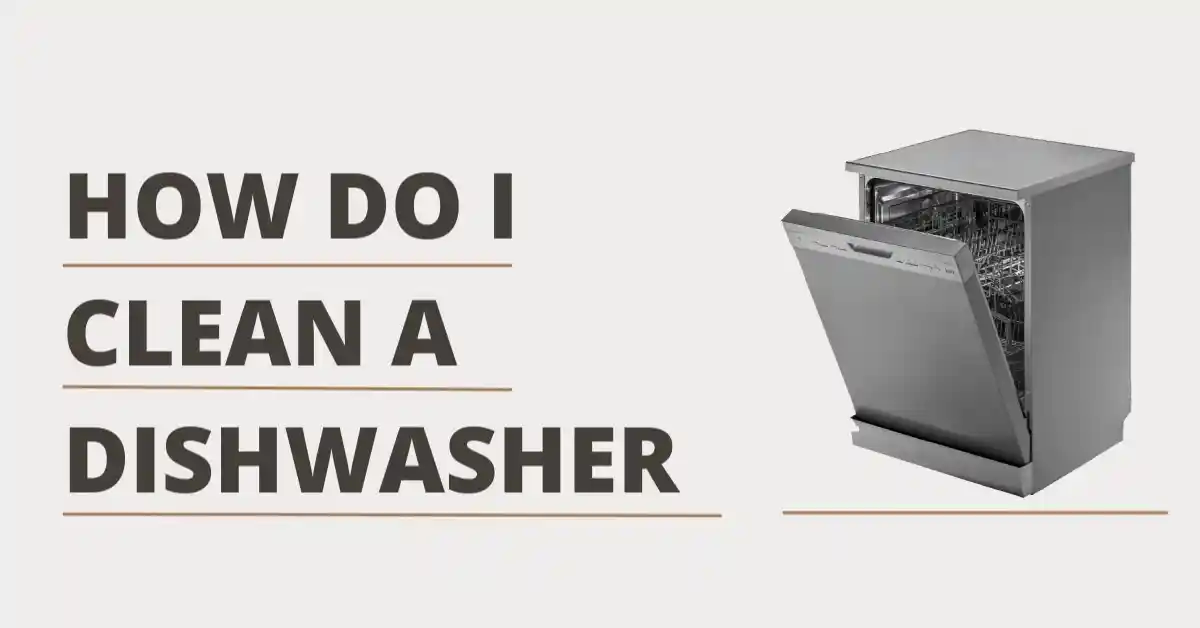Though it may seem daunting to clean your dishwasher, it is necessary for its efficiency and hygiene.
In this guide, we will show you how to effectively clean a dishwasher to remain in good working condition.
By following our step-by-step instructions, which include using natural cleaning agents and addressing common problems like smells or dirt, you will have a shining dishwashing machine within minutes.
Besides, we would also teach you the best methods to cleanse dishwashers hence ensuring they are spotless and smell pleasant; therefore, avoid all mistakes when doing such washing.
If you’re wondering, how do I clean a dishwasher, you’ll find all the answers and tips you need right here.
The importance of cleaning a dishwasher
Regularly cleaning your dishwasher is crucial for preventative home maintenance.
Failure to do this leaves residues such as minerals, oil, dirt, and limescale inside the apparatus thus making them less efficient as time goes by.
Your dishes will not be cleaned by the dishwasher leading to problems like plates with stuck food on them and hazy glasses too can result from dirty dishwater.
This can require expensive repairs if not properly functioning anymore.
A messy dishwasher can make your kitchen smell bad so follow these tips and clean it every once in a while as will benefit future meals when the present kitchen experience remains fresh but uses less energy than what had been before.
ALSO READ: 10 Common Dishwasher Mistake You Should Avoid.
What is the recommended frequency for cleaning your dishwasher?
The frequency of cleaning a dishwasher is related to the number of cycles performed either daily or weekly.
If you use it every day, some activities should be done daily, others weekly and monthly to ensure that your dish cleaner stays clean.
- Clean daily or after every use: Remove any food particles from the filter well and the bottom of the dishwasher.
- Every 7 Days: Wipe off dirt on door edges and gasket then pull out and wash the filter.
- Every 30 days: Clean by running a washing cycle inside.
- if necessary: Scrub off any drops, spots, or film from its exterior, boundaries, and inside as well.
How do I clean a dishwasher step-by-step Guide?
Here are these steps:
Steps 01: What You’ll Need for Cleaning Dishwasher
Yet, before washing the dishwasher You will find many things that can be used for this process but for this method, these are the most important ones:
- lukewarm water.
- Dishwashing soap.
- Distilled white vinegar.
- Baking soda.
- Picktooth.
- Used toothbrush.
- Microfiber cloths.
- Sponge.
- Protective gloves.
Note: Experts also advise against using bleach in any case that involves cleaning dishwashing machines like this one!
Step 02: Remove the filter, utensil containers, and shelves from the dishwasher
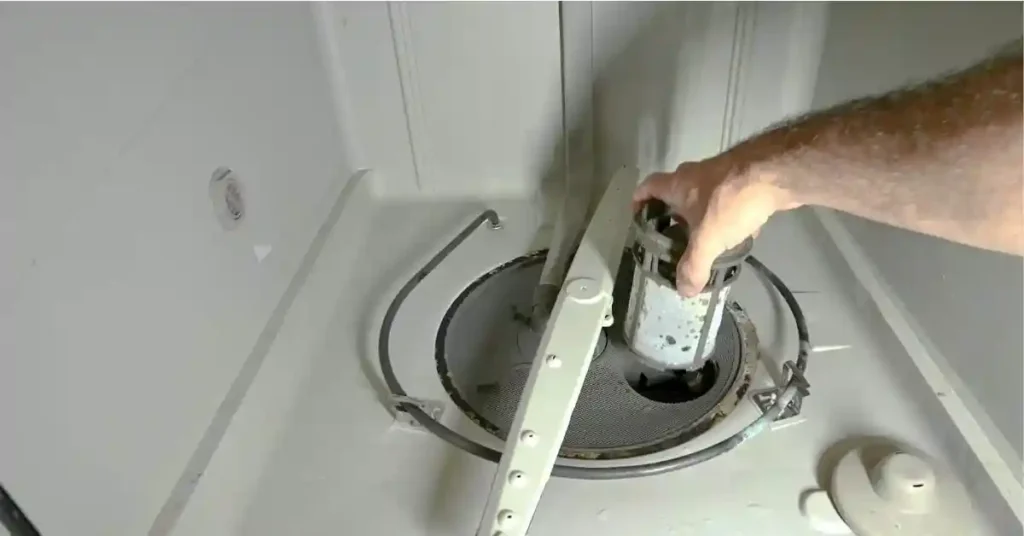
To access the small, detailed spaces, start by removing the racks, utensil holders, and filter from your dishwasher. Some filters can be easily twisted off, while others may require tools to dismantle.
Once removed, soak them in warm water and one cup of white distilled vinegar, filling about half of your sink. Allow them to soak for at least 30 minutes. Use a soft toothbrush to scrub the gaps and mesh in the filter before moving on to the next step.
Before reinstalling the dishwasher filter, ensure you clean the surrounding area to remove any leftover food debris or odors.
Step 03: Get rid of food particles and debris
After ensuring you have a clear view, inspect carefully for any remaining debris that may be concealed. Following this, the expert suggests using soapy water to clean the interior walls and corners. Then, shift your focus to the spray arms.
“Food particles can become stuck in the small holes of the spray arms, preventing water from reaching your dishes,”
Examine the arms and dispenser, and inspect all the small openings where water is sprayed out. If you notice food debris or other substances trapped in these small spaces, you can utilize a toothbrush or toothpick to remove them.
Step 04: Utilize vinegar and baking soda to freshen up the interior of the appliance
After everything has been wiped manually; time use vinegar and baking soda to ensure that the interior parts shine bright.
“How to clean dishwasher with vinegar and baking soda”
The dishes should however be removed before using vinegar to rinse the Dishwasher’s interiors according to these steps.
Conduct a Vinegar Cleaning Cycle:
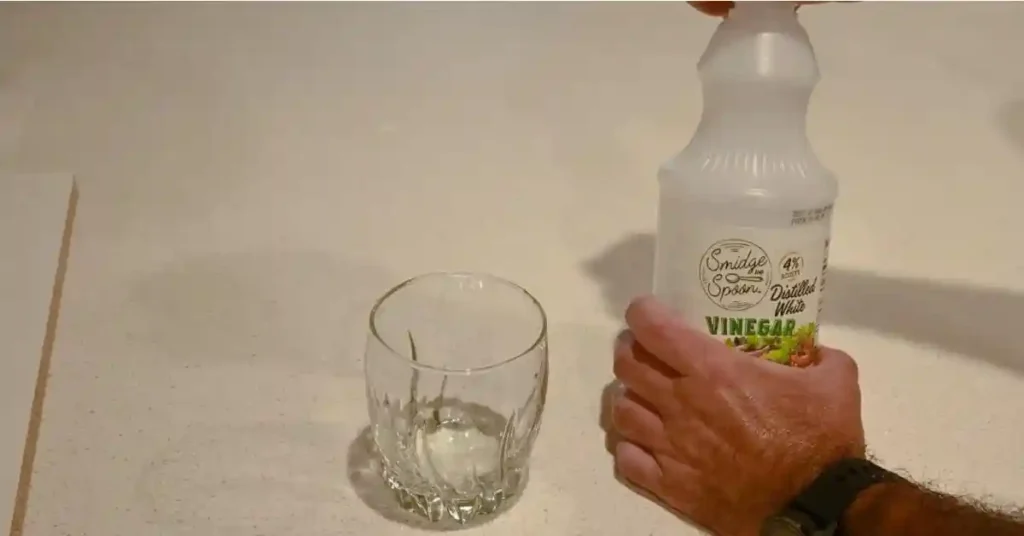
- Remove and wash the filter of the dishwashing machine to eliminate any buildup or obstructions. For some filters, consult your manual if you cannot remove them.
- Pour one cup of distilled white vinegar into a glass or plastic container.
- Leave the container of vinegar uncovered on the top shelf of the dishwasher.
- Choose a regular cycle for this stage.
- This is optional if you would like to save on energy bills by skipping the drying cycle.
Tips: “When using vinegar rinse, dish detergent is not required. A combination of water and vinegar produces a strong cleansing solution.”
Baking Soda Wash:

The use of vinegar rinse will remove any build-up of grease while the baking soda rinse will remove any remaining smells completely.
- Immediately after the first cycle dissolve 1 cup of baking soda on the dishwasher’s bottom.
- At that moment hot water should enter into dishwasher during cycle starting.
- Air dry out when the cycle is finished, opening your dishwasher door. This helps to keep it clean and smell fresh all the time from inside your dishwasher room.
Caution: “Do not mix both vinegar and baking soda when cleaning at one go since they foam up thus creating a very complicated situation during the clearing-up process later on.”
Step 05: Clean the filter every month
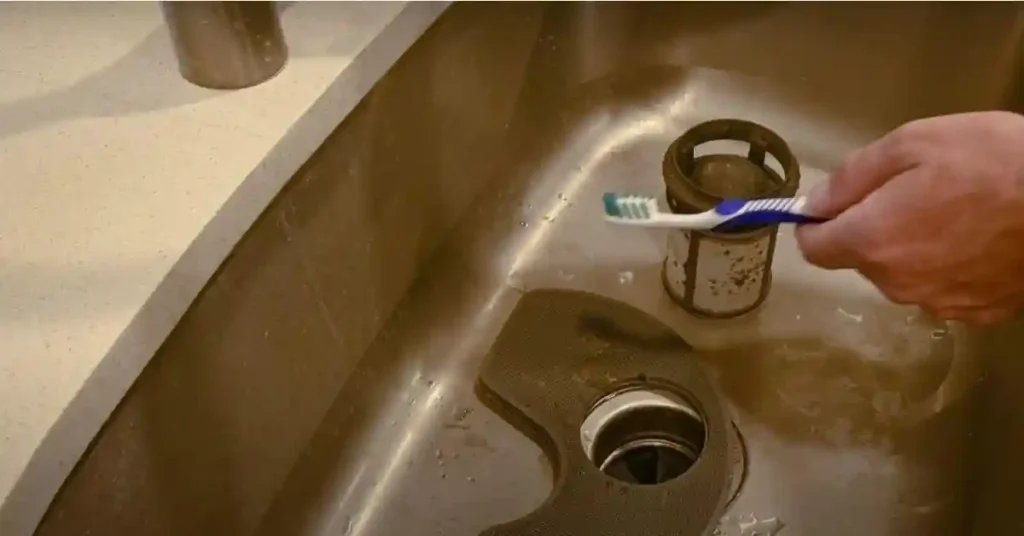
- Your machine has a filter there in the bottom which you can remove if you pull out the lower rack and reach from the bottom of your dishwasher.
- Look for arrows that will show you how to unlock this cylindrical filter when twisting it; take off.
- The sink is where we should leave this filtering mechanism for some time to soak in a mixture of water and washing liquid.
- Use an old toothbrush or any other such thing to clean the filter well.
- Then, reattach the filter securely in place where it was before.
Expert advice: “Make sure that your machine has a filter tightly locked up so that no damage can be caused by dishwashing activity warranting eventual loss of warranty if breached.“
Step 06: Monthly cleaning of the spray arms is required
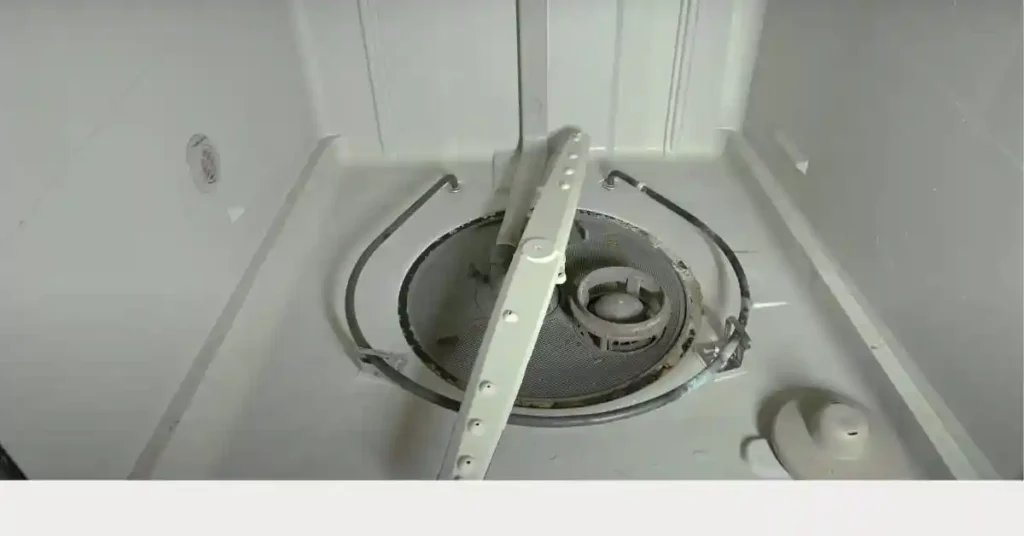
The water circulates the dishwasher through small holes located on each spray arm, but these may become blocked by accumulated minerals from hard water or food particles.
In case such openings are obstructed, not all dishes will be reached by water leading to dirty dishes in general.
- Cleaning these sprayer arms while the dishwasher is not being used is a good starting point.
- If possible please lift both the upper tray and lower racks so that spray arms can be accessed easily with enough water pressure applied during the cleaning process.
- Gently insert a wire into every hole using your fingers to clear all obstacles away from them and leave no debris inside or outside.
step 07: Clean rubber seals should be maintained every month
- Inspect the seals for leftovers or fungus.
- Wipe them clean using a moist cloth.
- Clean using a mild detergent or a baking soda paste.
- Scrub carefully and use a soft brush or an old toothbrush to get off stubborn stains.
- After rinsing well, use a clean wet cloth to clear away any residue.
- Leave the door open to allow the seals to dry up.
Step 08: Clean the dishwasher extra parts every month
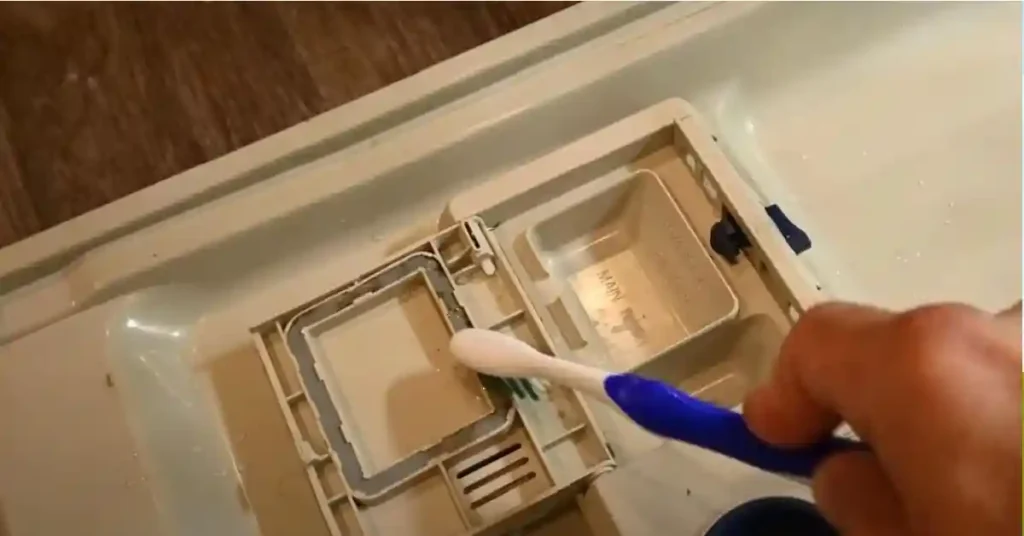
- Use your used toothbrush to sweep away any dirt that may be trapped within the grid of the utensil holder.
- Remove any deposits clinging to it from the soap dispenser.
- Let them soak in warm water with some soap mixed in it to help loosen dirt and debris.
- For areas that are difficult to reach and corners, you should employ a gentle brush for cleaning purposes.
- Rinse out the remaining soap with fresh water.
- Dry naturally before reassembling it back together again.
Step 09: Wipe down the exterior of the dishwasher door
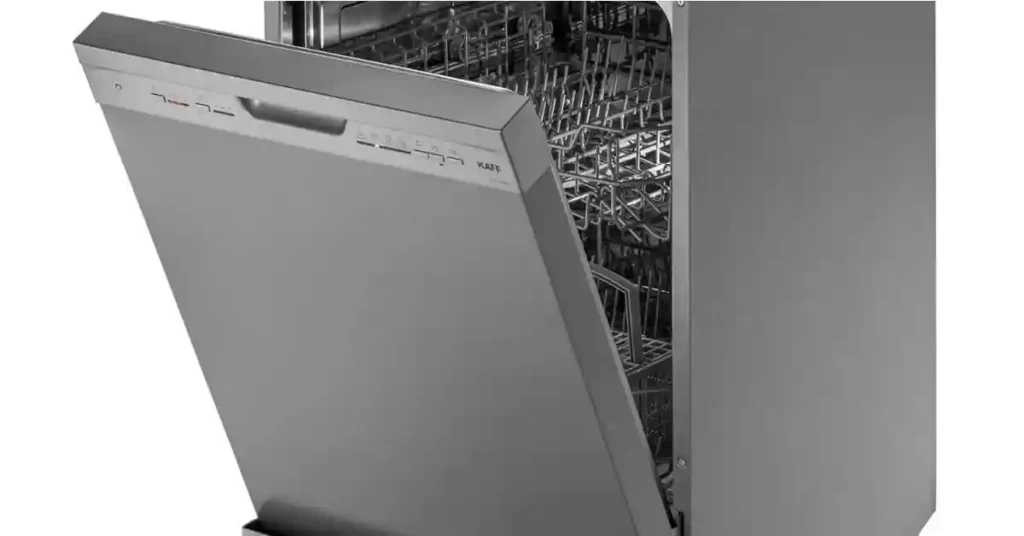
Being able to clean the inside of your dishwasher is vital but one should also remember that the exterior needs cleaning too.
- Choose an appropriate cleaner specifically meant for stainless steel.
- Pick Microfiber Cloth for non-streak cleaning experience which is also very effective.
- Make your cleaning solution by combining dish soap, water, and white vinegar in a container.
Cleaning Process:
- Take the cloth and dip it into the homemade cleaner.
- There should be enough liquid to let it flow out.
- Rinse it well until you are sure that there is no spot left on the fabric.
- Ensure that you also wipe clean the control panel and handles.
step 10: Various choices for stainless steel
One can opt to use any of two methods to tidy up a stainless steel dishwasher door:
- A microfiber material is needed together with a cleaner developed for stainless steel surfaces if one wants to make this way effective in removing such dirt from his or her appliance’s surfaces; therefore, take care that each sweep should be made by moving across only once — but along with the grain direction which must never change here as previously mentioned about grain’s naturalness towards metals.
- On the other hand, one can use gentle dish soap mixed with water to clean the outside of it as an alternative plan.
How to deep clean the dishwasher With Dishwasher Cleaner?
If the mixture of baking soda and vinegar fails to work out, you may try a certain cleaning agent designed specifically for dishwashers.
This special dishwasher cleaner is made to get rid of limescale and mineral deposits.
Limescale can be removed from glassware and dishes by using this during a normal dishwasher cycle.
To avoid cloudiness on glassware it is essential to remove limescale buildup. It is advised that you clean your dishwasher thoroughly once a month to remove any lodged particles, mineral deposits, or detergent residue inside the internal components as well as spray arms.
How to clean dishwasher with bleach?
Always avoid using bleach or cleaners containing bleach in dishwashers, especially those with stainless steel interiors.
Some dishwasher detergents may have bleach for removing tea and coffee stains; however, “mixing bleach with vinegar can create harmful chlorine gas.”
During cleaning of the dishwashers with bleach, care should be taken not to damage them, particularly those having stainless steel parts.
It is better not to use bleach at all for any dishwasher washing job.
Advice on Maintaining a Cleaner Dishwasher for a Longer Period
- Make sure that spills and splatters are cleaned up weekly without wastage of time.
- Rinse dishes before loading them into the machine to eliminate large food particles on them.
- Keep up with your dishwasher’s cleaning schedule. Clean it immediately if you find residues in the dishwasher or observe that the dishes are not clean anymore.
- Before placing them inside a dishwasher, remove food remains from plates.
- Don’t put any dishwasher-incompatible items such as food labels or other non-dissolving materials.
- If you don’t want to experience scummy dishes, do not overload your machine otherwise it will not be able to circulate water properly.
- Water Softener Look into getting a water softener to reduce limescale build-up.
- Run Garbage Disposal To avoid blockages clear the drain before you start the dishwasher.
FAQs
What is the best thing to clean the inside of a dishwasher?
The best way that I have seen to clean out a dishwasher is white vinegar. Vinegar is great at slicing through oils and mineral deposits which can cause stubborn dirt on kitchen appliances Simply place a cup of white vinegar in a dish-safe container on the top rack and run through a hot water cycle This will leave your dishwasher fresh and clean.
What is the best way to clean and deodorize a dishwasher?
Cleaning and deodorizing your dishwasher is key to keeping it working properly and odor-free. Here’s how to get your dishwasher sparkling and smelling fresh:
1. Empty the Dishwasher: Take out all dishes, racks and utensils. If your dishwasher has a filter take it out and rinse it under warm water to remove food bits.
2. Check for Debris: Check the drain and spray arms for blockages. Remove any food particles or buildup that could be blocking water flow.
3. Clean with Vinegar: Place a cup of white vinegar on the top rack in a dishwasher-safe container. Run a hot water cycle to break down grease, grime, and odor.
4. Baking Soda: Sprinkle one cup of baking soda on the bottom of the dishwasher and run a short hot cycle. This will deodorize and add sparkle to the interior.
5. Stubborn Odours: For tough smells use a dishwasher-safe deodorizer or a few drops of essential oil with baking soda before running a cycle.
6. Wipe Down: Use a damp cloth or sponge with mild dish soap to clean the edges, door seal, and exterior of the dishwasher.
Does baking soda clean a dishwasher?
Yes, Baking soda too can help to make your dishwasher cleaner The odor eliminator also does an excellent job gently washing away food leftovers and stains Sprinkle one cup of baking soda on the base of the appliance then run short-hot-water-cycle Your dishes shall shine forth sparklingly with just few specks
Is it OK to run dishwasher empty?
Yes, it is perfectly fine to run an empty dishwasher. This is often done to clean the machine itself. You can run a cleaning cycle with or without detergent, but using vinegar and baking soda is recommended for a deeper clean. It’s a good practice to clean your dishwasher regularly to ensure it operates efficiently. However, for regular dishwashing purposes, it’s more energy and water-efficient to run the dishwasher when it’s full.
Conclusion.
Ensuring that your dishwasher stays clean is important to maintain its effectiveness and guarantee that your dishes are spotless every time.
Fortunately, it is not a complicated task! You can take a few simple steps to clean your dishwasher and keep it operating smoothly.
These steps involve getting rid of any dirt or buildup, running a cycle with vinegar or baking soda, and wiping the inside and outside of the dishwasher.
By regularly following these easy steps, you can help prolong the life of your dishwasher and preserve its like-new functionality.
In this article, I have covered all relevant questions and answers on how do I clean a dishwasher. If you have any inquiries, feel free to contact us.
Don’t hesitate to share this informative article with your family and friends.
